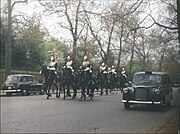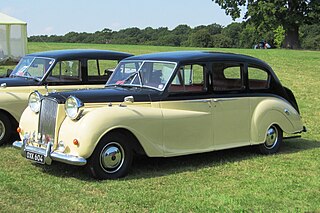
The Austin Princess is a series of large luxury cars that were made by Austin and its subsidiary Vanden Plas from 1947 to 1968. The cars were also marketed under the Princess and Vanden Plas marque names.

A hackney or hackney carriage is a carriage or car for hire. A hackney of a more expensive or high class was called a remise. A symbol of London and Britain, the black taxi is a common sight on the streets of London. The hackney carriages carry a roof sign TAXI that can be illuminated to indicate their availability for passengers.
Manganese Bronze Holdings plc (MBH) was the holding company of LTI Limited. The firm's sole business in its final years as a company was London black taxicab manufacturing through the LTI subsidiary.

The Metro is a supermini car, later a city car that was produced from 1980 to 1998, first by British Leyland (BL) and later by the Rover Group. It was launched in 1980 as the Austin Mini Metro. It was intended to complement and eventually replace the Mini, and was developed under the codename LC8. The Metro was named by What Car? magazine as "Car of The Year" in 1983 as an MG, and again as the Rover Metro in 1991.
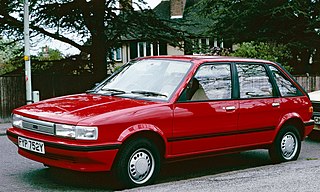
The Austin Maestro is a five-door hatchback small family car that was produced from November 1982 to 1986 by British Leyland, and from 1986 until December 1994 by Rover Group, as a replacement for the Austin Maxi and Austin Allegro, with the van version replacing the corresponding van derivative of the Morris Ital. The car was produced at Morris' former Oxford plant, also known as Cowley, with 605,000 units sold. Today, the redeveloped factory builds the BMW Mini. An MG-branded performance version was sold as the MG Maestro from 1983 until 1991.

The Austin Montego is a British family car that was produced by British Leyland from 1984 until 1988, and then by Rover Group from 1988 until 1995. The Montego was the replacement for both the rear-wheel drive Morris Ital and the front-wheel drive Austin Ambassador ranges to give British Leyland an all-new competitor for the Ford Sierra and Vauxhall Cavalier.

The Austin Maxi is a medium-sized, 5-door hatchback family car that was produced by Austin and later British Leyland between 1969 and 1981. It was the first British car to feature a hatchback body style.

The LDV Pilot was the last of a series of a panel vans that was produced by from 1974 until 2005, originally as the 1974 Leyland Sherpa developed by the Austin-Morris division of British Leyland, which was in turn derived from earlier light commercials produced by the British Motor Corporation.
Carbodies was a taxi design and manufacturing company based in Coventry, England. In its latter years it also traded as London Taxis International and The London Taxi Company.

The LTI TX1 is a Hackney carriage introduced by London Taxis International in 1997 and designed to replace the ageing Austin FX4. It was designed by British product designer Kenneth Grange.

The Nuffield Oxford Taxi, initially produced as the Wolseley Oxford Taxicab was the first new taxicab designed to comply with the Metropolitan Police Conditions of Fitness for London taxicabs to be launched on the British market after the end of the Second World War.

The LDV Convoy is a light commercial van that was manufactured from 1986 until 2006. The Convoy was a development of the Leyland DAF 400 Series, which in turn was based on the Freight Rover 300 Series. The Convoy and its predecessors were wider and longer versions of the LDV Pilot, all based on the Leyland Sherpa series of vans from 1974.
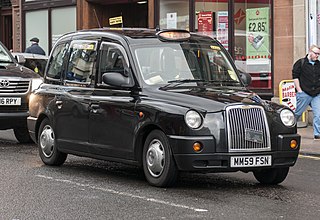
The TX4 is a purpose-built taxicab manufactured by The London Taxi Company, a subsidiary of Geely Automobile of China. From 2007 until their liquidation in 2013 it was manufactured by LTI. It is the latest in a long line of purpose-built taxis produced by The London Taxi Company and various predecessor entities. The design has evolved via several mutations from the Austin FX3 of the 1950s. TX4's immediate predecessor is the TXII.

The Austin FX3 is a taxicab that was sold in the United Kingdom by Austin from 1948 to 1958. It was designed to comply with the Metropolitan Police Conditions of Fitness for London taxicabs, but was also used in other towns and cities in the UK. It was commissioned from Austin by taxi dealers Mann & Overton and built by Carbodies of Coventry on a chassis supplied by Austin.

The Ford Thames 400E is a commercial vehicle that was made by Ford UK and introduced in 1957. Production of the range continued until September 1965, by which time a total of 187,000 had been built. Publicity for the model included hiring the Cy Laurie band to make the promotional film short 'Band Wagon', in 1958, preserved in the 'Ford Film and Video Collection' at the National Motor Museum, Beaulieu

Engines used by the British company Land Rover in its 4×4 vehicles have included four-cylinder petrol engines, and four- and five-cylinder diesel engines. Straight-six cylinder engines have been used for Land Rover vehicles built under licence. Land Rover has also used various four-cylinder, V8, and V6 engines developed by other companies, but this article deals only with engines developed specifically for Land Rover vehicles.

The Austin London Taxicab used a modified Austin Heavy Twelve-Four chassis clothed with new bodies designed by London's largest taxicab retailer and dealer Mann & Overton, and made for them by London coachbuilders.
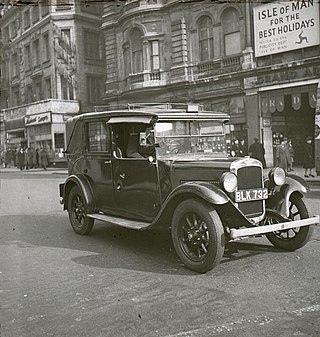
Mann & Overton Limited owned and operated a motor vehicle dealers business previously known as Mann & Overton's and established 14 May 1901 which came to specialise in the supply and financing of London taxicabs, first Unic then Austin Taxicabs, eventually holding the concession for the Austin taxicab chassis for the whole of the Metropolitan Police Area of London.
The Austin D and K series engines are a straight-six engine made by the British Austin Motor Company between 1939 and 1968. It was developed initially for the lorry market; but was used in a number of automobiles in its later life. It was an overhead valve non-crossflow cylinder head design. Both block and head were made out of cast iron. All engines had a forged four main bearing crankshaft.


















